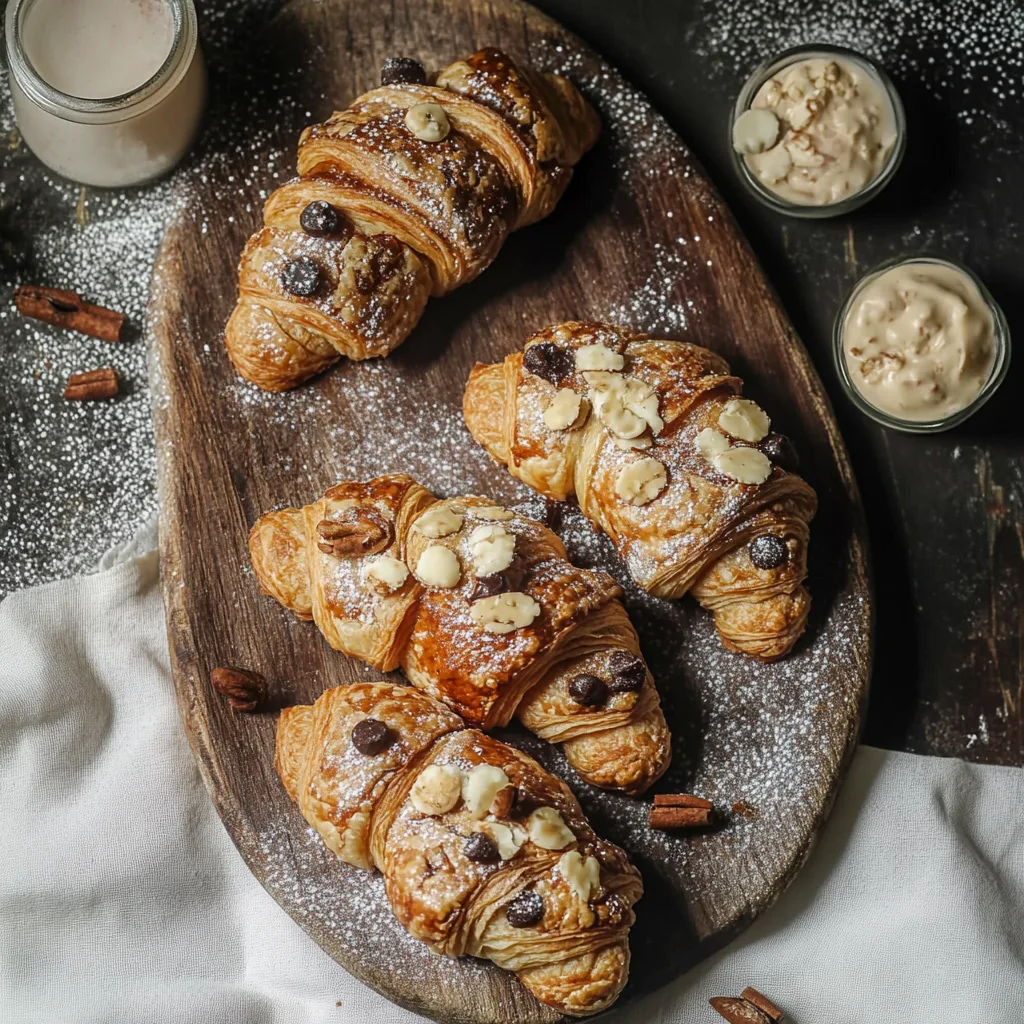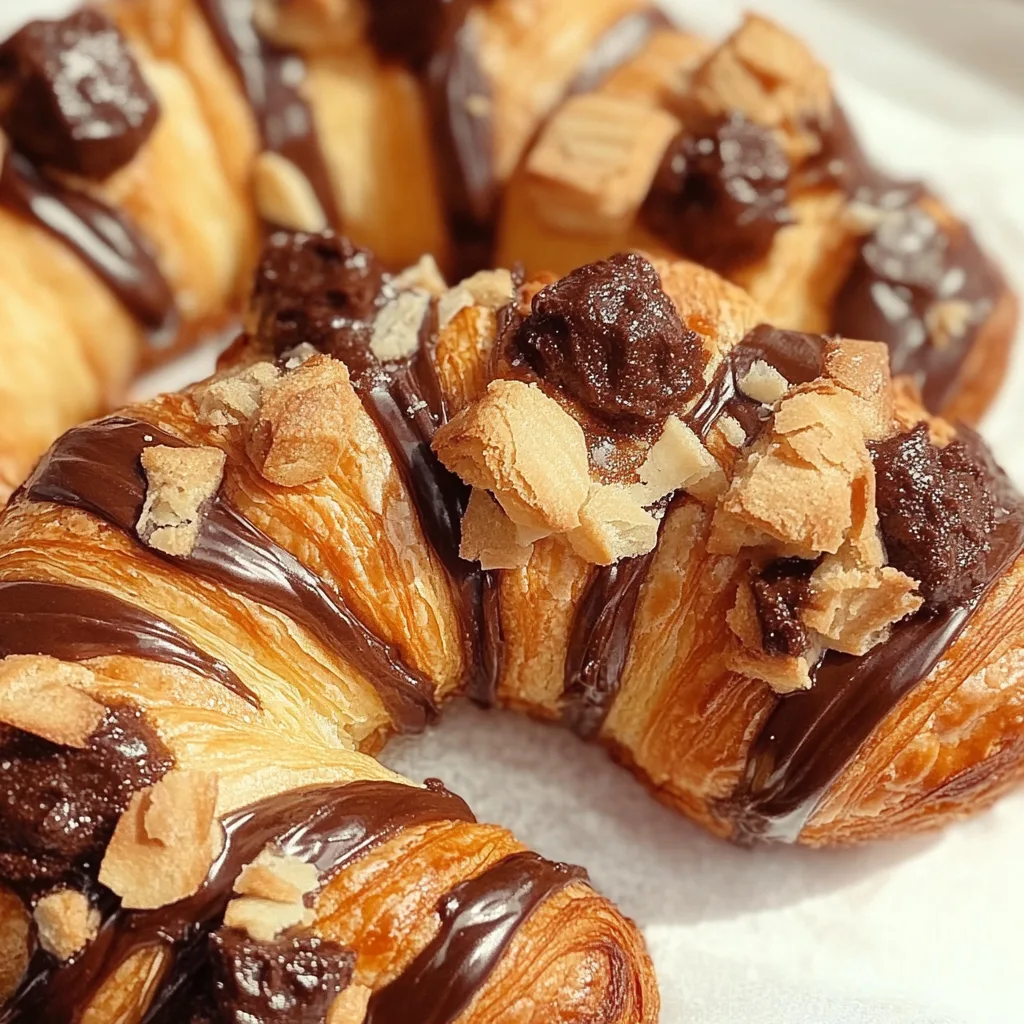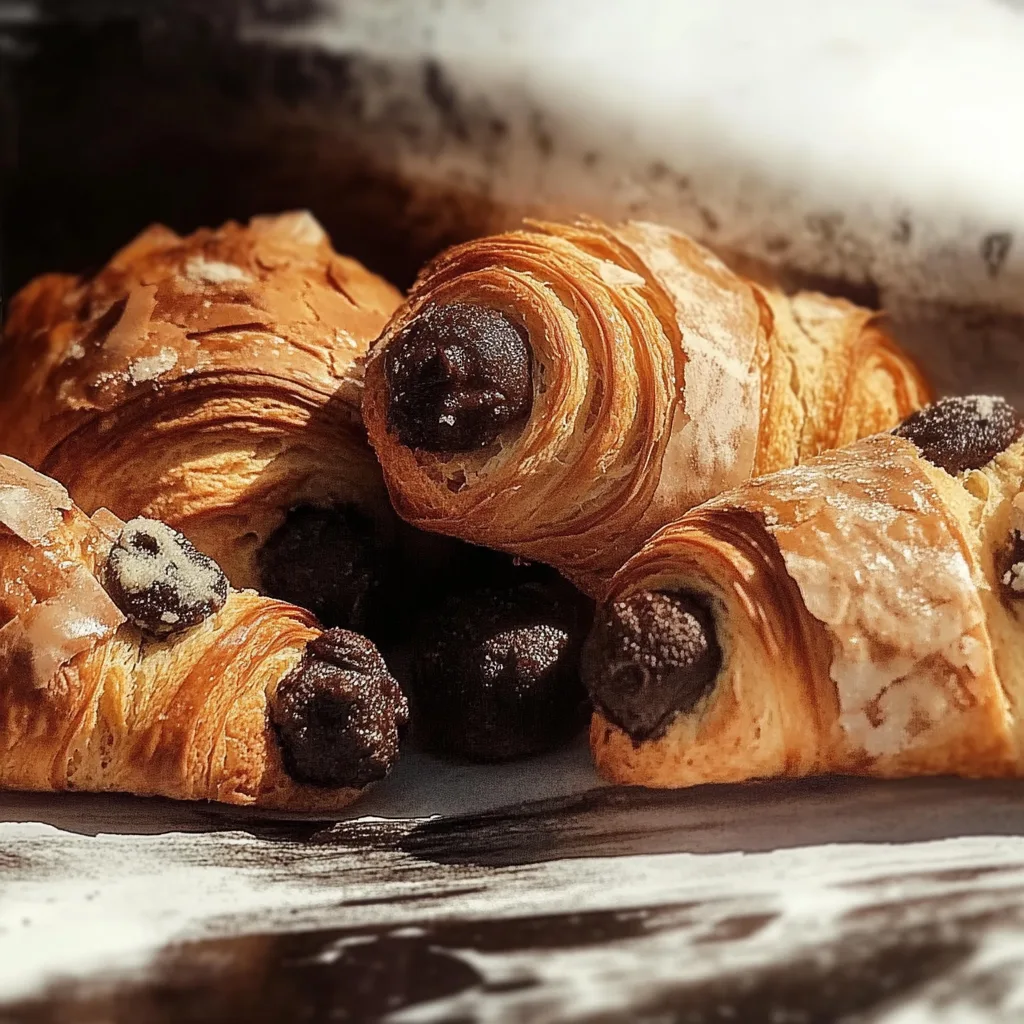Cookie croissants
Cookie croissants—part croissant, part cookie, and 100% indulgence—are the culinary lovechild taking over social feeds and bakery menus. Imagine biting into a golden, buttery croissant layered with pockets of warm, melty cookie dough. This guide explores their origins, baking secrets, creative twists, and answers every question you’ve ever had. By the end, you’ll be ready to bake (or hunt down) these heavenly hybrids.

Picture this: a golden, flaky croissant, its delicate layers shimmering with buttery perfection, cradling pockets of warm, gooey cookie dough that oozes with every bite. This is the cookie croissant—a pastry masterpiece that’s storming Instagram feeds, dominating TikTok trends, and redefining breakfast-dessert hybrids. Born from the audacious creativity of modern bakers, this fusion treat merges the elegance of French viennoiserie with the nostalgic comfort of a freshly baked cookie. But what makes it so irresistible?
In the last three years, cookie croissants have skyrocketed from niche bakery experiments to global sensations. Searches for “cookie croissant near me” surged by 450% in 2023, while food influencers rack up millions of views deconstructing their crisp-chewy layers. From Parisian patisseries to Brooklyn pop-ups, bakers are riffing on the trend, stuffing croissants with everything from salted caramel cookie dough to matcha-infused white chocolate chunks. Even Starbucks capitalized on the craze, launching a chocolate chip cookie croissant that sold out in hours.
But this isn’t just another fleeting food fad. The cookie croissant taps into a deeper culinary zeitgeist: the demand for hybrid indulgences that blur the lines between meals. It’s a croissant you can justify eating at 8 AM (thanks to its “breakfast” label) and a cookie you can savor guilt-free with afternoon coffee. Its versatility is unmatched—serve it plain for a minimalist treat, dunk it in espresso for a Parisian café vibe, or crown it with ice cream for a showstopping dessert.
In this definitive guide, we’ll unravel the secrets behind the cookie croissant phenomenon. You’ll discover:
- The origin story: How a TikTok video sparked a global pastry revolution.
- Baking science: Why cold butter and laminated dough are non-negotiable for flaky layers.
- Pro hacks: Tips from award-winning bakers to avoid soggy bottoms and butter leaks.
- Trendsetting twists: From vegan and gluten-free versions to savory-spiced surprises.
Whether you’re a home baker eager to master laminated dough or a foodie hunting for the ultimate indulgence, this guide is your passport to the world of cookie croissants. Let’s bake, break, and bask in the layers.
Part 1: The Rise of Cookie Croissants – History, Ingredients, and Baking Science
1. The Evolution of Hybrid Pastries: From Cronuts to Cookie Croissants
The cookie croissant didn’t emerge in a vacuum. Its story begins with the 2013 Cronut® craze, where Dominique Ansel fused croissants with donuts. Fast-forward to 2021: home bakers began experimenting with stuffing croissant dough with chocolate chip cookie dough, and TikTok catapulted the trend to fame. By 2023, chains like Starbucks and Paris Baguette added their own spins, cementing the cookie croissant as a mainstream obsession.
Key Moments:
- 2021: A Brooklyn home baker’s viral TikTok video showcased layered croissant dough swirled with cookie butter.
- 2022: French pastry chefs criticized the trend as “sacrilege,” sparking debates (and free publicity).
- 2023: Google searches for “cookie croissant recipe” spiked by 290%.
2. The Anatomy of a Perfect Cookie Croissant: Ingredients Decoded
To master cookie croissants, you need to understand the science behind their two core components:
A. Laminated Dough: The Heart of Flakiness
- Cold butter: Creates steam during baking, puffing up the layers.
- High-protein flour: Provides structure (aim for 12-14% protein content).
- Patience: Resting the dough between folds is non-negotiable.
B. Cookie Dough: Sweetness with Structure
- Cornstarch: Secret ingredient for chewy cookie texture.
- Brown sugar: Adds moisture and caramelized flavor.
- Chilling: Prevents the dough from melting too quickly in the oven.
Pro Tip: For a deeper dive into dough science, explore our guide on Mastering Laminated Pastries, which breaks down gluten development and butter distribution.
3. Step-by-Step Recipe: Crafting Cookie Croissants at Home
Ingredients (Serves 12):
- Laminated dough: 500g (homemade or store-bought)
- Cookie dough: 200g (classic chocolate chip or custom flavors)
- Egg wash: 1 egg + 1 tbsp milk
Tools You’ll Need:
- Rolling pin
- Pastry brush
- Baking stone (for even heat distribution)
Instructions:
Day 1: Prepare the Dough
- Laminate the dough: Fold butter into the dough using the “letter fold” method. Repeat 3x, chilling 30 minutes between folds.
- Shape: Roll dough into a 12×16-inch rectangle.
Day 2: Assemble and Bake
- Layer cookie dough: Crumble chilled cookie dough evenly over the dough.
- Roll and cut: Slice into triangles, roll into crescents, and proof at 75°F for 2 hours.
- Bake: 375°F for 18–22 minutes until golden.
Why This Works: The cookie dough caramelizes between the croissant layers, creating a crisp-chewy contrast.
Common Mistakes:
- Soggy layers: Overloading with cookie dough traps moisture. Stick to 200g max.
- Butter leakage: Ensure dough is chilled before baking.
For troubleshooting, see our guide Why Your Pastry Fails, which tackles uneven baking and texture issues.

4. 10 Creative Cookie Croissant Variations to Try
- S’mores Cruffissant: Layer marshmallow fluff and crushed graham crackers.
- Matcha-White Chocolate: Add ceremonial-grade matcha to the dough and stuff with white chocolate chunks.
- Savory-Spiced: Mix cheddar cheese into the dough and sprinkle with smoked paprika.
- Vegan Delight: Use coconut oil butter and flaxseed “eggs.”
- Gluten-Free: Substitute with almond flour and xanthan gum (note: denser texture).
Pro Inspiration: Parisian bakery L’Éclair de Génie debuted a salted caramel cookie croissant dipped in Valrhona chocolate—a masterclass in luxury.
Part 2: Advanced Techniques, Serving Ideas, and Trends
5. Pro Tips from Award-Winning Bakers
- Temperature control: Keep dough at 60°F during lamination to prevent butter from melting.
- Egg wash hack: Add a pinch of salt to the wash for extra shine.
- Freeze for later: Unbaked cookie croissants can be frozen for 3 months. Bake straight from the freezer!
Tool Spotlight: A marble pastry board stays cooler than wood, making it ideal for laminating.
6. Serving & Pairing: Elevate Your Cookie Croissant Experience
- Breakfast: Pair with a cappuccino and fresh berries.
- Dessert: Serve warm with vanilla bean ice cream and a drizzle of salted caramel sauce.
- Brunch Board: Include mini cookie croissants alongside charcuterie and fruit.
Beverage Pairings:
- Coffee: A bold espresso cuts through the sweetness.
- Wine: Try a Riesling or Moscato for contrast.
- Tea: Earl Grey’s bergamot notes complement citrus-zested dough.
7. FAQs: Answering the Top 10 Cookie Croissant Questions
Q: Can I use store-bought croissant dough?
A: Absolutely! Pillsbury’s crescent rolls work in a pinch, but homemade dough delivers superior flakiness.
Q: How do I prevent the cookie dough from oozing out?
A: Chill the dough thoroughly and avoid overstuffing. For extra security, “seal” the edges with a fork.
Q: Are cookie croissants freezer-friendly?
A: Yes! Freeze unbaked pastries on a tray first, then transfer to a bag. Bake from frozen, adding 3–5 extra minutes.
Q: Can I make these vegan?
A: Swap butter for vegan margarine and use chia “eggs.” Check out our Vegan Baking 101 for detailed substitutions.
8. Troubleshooting Guide: Fix Common Cookie Croissant Fails
- Problem: Flat, dense layers.
Solution: Butter was too warm during folding. Chill dough longer between folds. - Problem: Burnt bottoms.
Solution: Use a baking stone or double-layer baking sheets. - Problem: Cookie dough sinks to the bottom.
Solution: Pre-bake the croissant for 5 minutes before adding dough.
9. 2024 Trends: What’s Next for Cookie Croissants?
- Mini cruffissants: Bite-sized versions for party platters.
- Global flavors: Think ube halaya (purple yam) from the Philippines or dulce de leche from Argentina.
- Healthier spins: Protein-packed dough with almond flour and collagen.
Conclusion: Why Cookie Croissants Are the Future of Pastry
The cookie croissant isn’t just a trend—it’s a revolution. By marrying the flaky sophistication of French pastry with the comforting sweetness of cookies, it bridges culinary worlds. Whether you’re a home baker or a pastry shop regular, this hybrid offers endless creativity. From vegan adaptations to luxury dessert pairings, cookie croissants prove that innovation thrives at the intersection of tradition and rebellion.
Ready to Bake? Tag us on Instagram with your cookie croissant creations—we’ll feature the most decadent twists!
Internal Links with Rich Anchor Text
- “Master the art of laminated dough in our comprehensive guide Mastering Laminated Pastries.”
- “Avoid common pitfalls with Why Your Pastry Fails, a troubleshooting manual for bakers.”
- “Explore vegan swaps in Vegan Baking 101, your plant-based pastry handbook.”
External Links (Embedded in Part 1)
- Learn about the Cronut®’s history from Dominique Ansel’s official site.
- Dive into butter science via King Arthur Baking’s guide.
Conclusion: The Cookie Croissant – A Culinary Revolution That’s Here to Stay
The cookie croissant is more than a pastry—it’s a symbol of culinary audacity. By merging the flaky sophistication of a French croissant with the unapologetic decadence of a cookie, this hybrid treat transcends borders, diets, and mealtime conventions. But its significance goes beyond layers of butter and sugar. It embodies a cultural shift in how we approach food: a demand for innovation without compromise, where tradition and rebellion coexist deliciously.
Why the Cookie Croissant Wins Hearts (and Stomachs)
- The Nostalgia Factor: It marries two universally beloved classics—croissants and cookies—into a single, irresistible bite. For millennials raised on chocolate chip cookies and Gen Zers obsessed with TikTok food trends, it’s a bridge between generations.
- Versatility as a Virtue: Unlike static pastries, the cookie croissant adapts to every craving. Stuff it with salted caramel for a luxury dessert, swap in oatmeal raisin dough for a breakfast twist, or infuse it with espresso powder for coffee lovers.
- Social Media Gold: Its photogenic layers and oozing fillings make it a viral sensation. A single drip of molten chocolate or dusting of powdered sugar can rack up millions of likes—a testament to its visual and visceral appeal.
The Future of Fusion Pastries
The cookie croissant is just the beginning. As chefs and home bakers push boundaries, we’re seeing:
- Miniature Marvels: Bite-sized cookie croissants for brunch boards and party platters.
- Global Flavors: Think matcha-red bean (Japan), cardamom-rose (Middle East), or dulce de leche (Latin America).
- Health-Conscious Twists: Protein-packed doughs, keto-friendly almond flour bases, and sugar-free cookie fillings for guilt-free indulgence.
But perhaps its greatest legacy is democratizing haute pastry. Once confined to patisseries with €10 price tags, the cookie croissant empowers home bakers to create luxury at home. With a rolling pin, patience, and our guide, anyone can craft a treat that rivals Parisian bakeries.
A Call to the Kitchen (and the World)
The cookie croissant isn’t just food—it’s an invitation to play. To experiment with brown butter cookie dough or sprinkle sea salt over dark chocolate shards. To share warm batches with friends or savor a solitary moment with coffee. It’s proof that food, at its best, is both art and joy.
As pastry chef Dominique Ansel once said, “Innovation is remembering what you know and seeing it anew.” The cookie croissant does exactly that: it reimagines the familiar into something extraordinary. So whether you’re laminating dough at 3 AM or hunting down the trendiest bakery in town, remember—every bite is a celebration of creativity.


